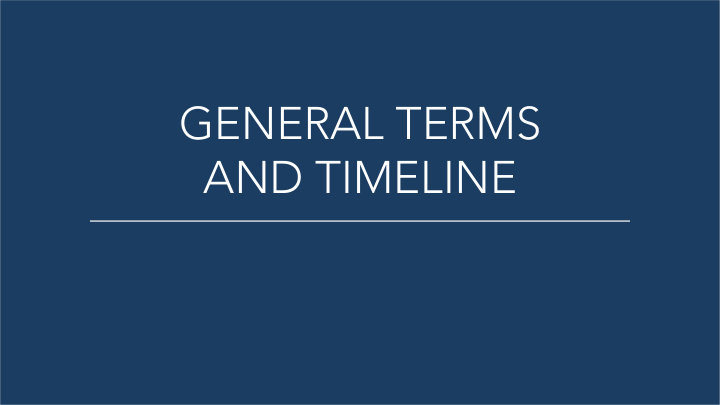



GENERAL TERMS AND TIMELINE
GENERAL TERMS AND TIMELINE Paycheck Protection Program Loans
Paycheck Protection Program Loans • Eligible small businesses with fewer than 500 employees may apply for the loan; • The loan can be up to 2.5 times the business’s average monthly payroll costs up to a maximum of $10 million; reduced by any amounts your business pays to individual employees over $100,000;
• The proceeds of the loan must be spent by the business within 8 weeks of the loan date; • 75% of the proceeds must be spent on payroll expense;
• 25% of proceeds can be used on other defjned expenses including, rent, mortgage interest payments, and utilities; • The loan term is 24 months with a 1% annual interest rate ;
• Payments are automatically deferred for 6 months – however interest does accrue during the deferral period; • After the deferral period, any amount of the loan left outstanding and any interest accrued will be repaid with fully amortized interest and principal payments over 18 months.
LOAN FORGIVENESS The forgiveness is dependent on:
1. The business having properly calculated its loan amount at application;
1. The business having properly calculated its loan amount at application; 2. Whether the business fully deployed the loan funds during the 8 week loan deployment period ; and
1. The business having properly calculated its loan amount at application; 2. Whether the business fully deployed the loan funds during the 8 week loan deployment period ; and 3. Whether the loan funds were spent on qualifjed expenses in the qualifjed amounts.
8 WEEK DEPLOYMENT PERIOD
8 WEEK DEPLOYMENT PERIOD For Qualifjed Expenses
• 75% of the funds must be spent on paying qualifjed payroll costs for your employees – remember you cannot use the funds for any person’s compensation in excess of $100,000.
• 25% of the loan funds can be spent on group health care benefjts being paid for employees currently on sick, medical or family leave, and related insurance premiums, rent, mortgage interest, for interest payments on loans taken before February 15 of this year and on utilities.
• You may also refjnance a disaster recovery loan or EIDL issued by the SBA.
• By accepting the funds your business is agreeing to re-employ its workforce if you reduced it. Your business’s forgiveness amount will be reduced by the percentage difference between the average number of FTE on your payroll during the 8 week deployment period against the average number of employees you employed between January 1 and February 29 of this year or February 15 and June 30 of last year.
• For example, if your business had 100 employees on average in January and February of this year, and you had to lay off all but three employees. Your business’s maximum loan forgiveness would be 3% of the loan amount.
• There is a saving mechanism in the PPP – if you rehire all of your employees before June 30, 2020 and return them to their same pay level, the loan forgiveness will not be reduced by the reduction in payroll and FTE during the 8 week deployment period.
THE PROBLEM WITH THE NEW SBA INTERIM RULES
75% of the loan amount is required to be spent on payroll expenses.
It is impossible to meet this requirement without rehiring at least 75% of your workforce almost immediately.
It seems practically impossible to deploy 75% of the funds on payroll costs when your workforce is laid off.
If your business cannot re-open during this 8 week deployment period, rehiring workers might make little sense.
FORGIVENESS PERIOD
After the 8 week deployment period, your business will be able to apply with the Bank for forgiveness of all or part of your PPP loan.
• Your business will be required to submit documentation that proves that you fully deployed the Program funds, that the funds were used for a proper purpose and that the funds were spent in the proper ratio between payroll costs and other qualifjed costs.
• It is unclear whether the business or the owners will need to submit further certifjcations or statements when applying for forgiveness.
To date, none of the details of the process for forgiveness have been published.
• Once your business submits a complete forgiveness package, the Bank will have to assess your business’s records against the standards that will be published and determine the proper amount of forgiveness. The Bank will submit this fjnal calculation to the SBA for review and fjnal approval.
• You will want to submit your forgiveness application well before the 6 month deferral period ends and your business must start making principal and interest payments.
The SBA will only forgive outstanding principal on the loan.
• Your business will start making fully amortized, principal and interest payments after the end of the 6 month deferral over the remaining 18 months of the loan term.
• There is no pre-payment penalty so you can pay the outstanding balance at any time.
Recommend
More recommend